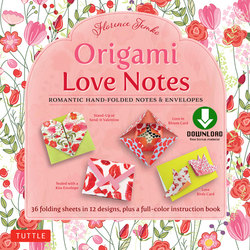Читать книгу Origami Love Notes Ebook - Florence Temko - Страница 6
На сайте Литреса книга снята с продажи.
ОглавлениеOrigami Techniques
Recognizing Symbols
By making this simple flower bud you will learn how to recognize the following origami diagram symbols:
Valley fold
Mountain fold
Follow this spot
Rotate symbol
Fold and unfold arrow
Fold in front arrow
Fold behind arrow
1. Begin with a square piece of paper, plain side up if you are using origami paper. Fold the paper in half, bottom corner to the top corner, and then unfold. Here you see what the valley fold (dashed line) is and what the fold and unfold arrow looks like. Next, notice the rotate symbol to the right of the diagram. This means that you must position your paper to look like diagram 2 before making the next fold.
2. By now, you should have rotated your paper so that the crease made in step 1 is running from the top corner to the bottom corner. Now lift up the bottom corner to make a fold, but do not lift it all the way to the top. See the X, “follow this spot,” at the bottom corner. You need to look ahead to diagram 3 to see where the X should go.
3. Fold up the left and right sides. Here, there is no X on the left and right sides. Even without the X, it is a good habit to look ahead to the next step, so you will be able to see what the paper should look like.
4. Fold the bottom corner to the back. Here you will see the mountain fold indication (a broken dashed line) and the arrow meaning “fold behind.”
5. Now you have the finished flower bud! Make several tiny buds from two-inch square papers and paste them onto the front of a handmade card, or save them to decorate another project.
Practicing Neat Folding
Neatness is important when you are folding. This simple exercise will help you practice matching edges—a straightforward task but a common problem for many beginners who do not realize how important it will become later on.
1. Begin with a square of paper, plain side up if you are using origami paper. Fold it in half, corner to corner, and then unfold. Be sure to match the corners and the edges of the square carefully before you press the paper flat to “commit” the crease.
2. Fold the two bottom edges to meet at the crease in the center. For neatness, fold only one side at a time. Leave an approximately one-millimeter gap between the two folded flap edges (to facilitate the fold in step 3), but be sure that the edges of the paper align with the crease exactly before you press the paper flat. This shape is often called the “Kite Base.” Many origami designs begin from this basic shape.
3. Fold the kite base in half, from left to right. This is a good way to check for neatness. Do all of the edges match? Are the corners neat?
4. Make several of these and use them to practice inside-reverse folding, as explained in the next section, where you will make an origami duck!
